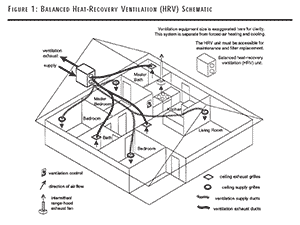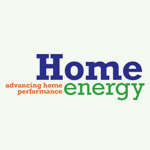Share
Related Topics
Tagged As
The air within homes can become stale from moisture, odors, and pollutants that penetrate the home or are generated internally by human activity and out gassing from building materials and furnishings. A constant supply of fresh outdoor air can provide a greater assurance of good indoor air quality and improved comfort.
We do not strictly control Google ad content. If you believe any Google ad is inappropriate, please email us directly here.
In most homes, ventilation is provided accidentally when air leaks through the building envelope. Accidental ventilation is unreliable because it is dependent on a pressure difference between indoor and outdoor spaces caused by temperature and wind variations. Too much fresh air often enters a house during cold weather causing uncomfortable drafts and high heating bills. Not enough fresh air may enter during mild weather which can lead to poor indoor air quality.
Air leakage through the building envelope accounts for between 25 percent and 40 percent of the energy used for heating and cooling in a typical residence. Many new homes are being sealed to reduce this energy use. Where tighter construction reduces air leakage and accidental ventilation, active ventilation systems may be needed to provide fresh air.
Figure 1* shows how a balanced ventilation system works in a small home. Fresh air enters the home through a single intake and is then distributed through ducts to the living and sleeping areas. Stale air is removed from the home through a separate exhaust duct with inlets typically located in areas such as bathrooms. The kitchen has a separate, manually operated exhaust fan located in the range hood. These systems can operate continuously or only when homes are occupied. The supply and exhaust fans are equal in capacity to maintain indoor pressure balance.
In severe climates, balanced ventilation systems can be equipped with a heat exchanger that recovers most of the heating and cooling energy from the exhaust air. These are also known as Heat Recovery Ventilators (HRVs) or Energy Recovery Ventilators (ERVs). There are two types of heat exchangers: sensible and total. Sensible heat exchangers recover dry heat. They are well suited for cold climates and are becoming common in many parts of Canada and the northern United States. Total heat exchangers transfer heat and moisture for additional humidity control. They work well in both cold and moderately humid climates, and can help prevent moisture-related problems. Balanced ventilation systems can be used safely with all types of heating and cooling equipment, but are more expensive than other ventilation systems (exhaust and supply ventilation).
Benefits
Balanced ventilation systems can provide many benefits including:
Improved indoor air quality. Balanced ventilation systems supply fresh air to the living and sleeping areas of homes while exhausting stale air at an equal rate from other areas. This proactive approach to ventilation can result in improved indoor air quality.
Improved comfort. ENERGY STAR labeled homes with tight construction and balanced ventilation systems can have fewer drafts and a constant supply of outdoor air resulting in improved comfort.
Improved health. Stale air can cause health problems. It can be responsible for symptoms such as headaches, drowsiness, and respiratory problems. These symptoms are more common in homes with poor ventilation and moisture control. Continuously providing fresh air can result in the improved health and well being of the occupants.
Lower utility bills. Less energy is consumed to operate ventilation systems than to heat and cool excessive amounts of outdoor air that infiltrates leaky homes. Additional savings are captured when these systems are equipped with either a sensible or total heat exchanger. This can result in lower utility bills, making homes less expensive to operate.
Improved resale position. ENERGY STAR labeled homes with balanced ventilation systems can provide the many impressive benefits listed including more comfortable homes with better indoor air quality and lower utility bills. These benefits can translate into higher resale value.
*Ventilation equipment size is exaggerated here for clarity. This system is separate from forced-air heating and cooling. The HRV unit must be accessible for maintenance and filter replacement.
HHI Error Correction Policy
HHI is committed to accuracy of content and correcting information that is incomplete or inaccurate. With our broad scope of coverage of healthful indoor environments, and desire to rapidly publish info to benefit the community, mistakes are inevitable. HHI has established an error correction policy to welcome corrections or enhancements to our information. Please help us improve the quality of our content by contacting allen@healthyhouseinstitute.com with corrections or suggestions for improvement. Each contact will receive a respectful reply.
The Healthy House Institute (HHI), a for-profit educational LLC, provides the information on HealthyHouseInstitute.com as a free service to the public. The intent is to disseminate accurate, verified and science-based information on creating healthy home environments.
While an effort is made to ensure the quality of the content and credibility of sources listed on this site, HHI provides no warranty - expressed or implied - and assumes no legal liability for the accuracy, completeness, or usefulness of any information, product or process disclosed on or in conjunction with the site. The views and opinions of the authors or originators expressed herein do not necessarily state or reflect those of HHI: its principals, executives, Board members, advisors or affiliates.









